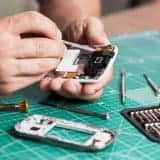Getting Started as a Freelance Photographer
Are you passionate about photography? You may be wondering how you can get started as a freelance photographer. On a market where competition is only getting more intense, we’re here with essential advice for anyone wishing to get started as a freelance photographer.
If you’re passionate about photography, it could be a great idea to combine it with your other interests in order to get started as a freelance photographer. For example, if you love sports, weddings, pets, hiking, or meeting new people, combining your interests will make for a lucrative photography practice. Whether you end up going into sports photography or fashion, landscape or street, and portrait or architecture will have to do with your own personal interests and where your other fields of knowledge lie. If you’re looking to get started as a freelance photographer, it’s likely that you already know which kind of photography is best suited to you. Here, we’ve assembled all the most important advice for you to take under consideration before you get started as a freelance photographer.
Even freelancers need solid business plans. Especially as a photographer, you’ll be practicing a profession that doesn’t come cheap. You’ll need to lay out how you plan to make a profit, maintain, replace, and repair gear, and more. Luckily, you can check out our free business plan templates for free download.
Get Started as a Freelance Photographer
As a freelancer, you’ll need to set up a sole proprietorship or an auto-enterprise in your region. You can check out our articles on getting started with this status in the United States, the UK, and France. In France, you’ll also want to look into the Maison des Artistes, a useful association that will help you should you wish to sell prints or exercise your photography in a more artistic capacity.
Being a freelancer means that you’ll have a lot of costs to take care of yourself — if you’ll be using your car to get to and from assignments, for example, your auto insurance will need to be changed to reflect the use of your vehicle. You’ll need to figure out health insurance, as well as purchase insurance on your equipment and liability for your business activity.
You’ll also need to know how much you work for, on an hourly as well as package basis, and in this respect, there are important points to keep in mind. As a freelance photographer, you’ll need to have your own gear in order to offer high-quality services and images to your clients, and this comes at a price to you as an individual. Beware of clients asking for free work, or work paid in “exposure.” It’s no way to make a sustainable living of your craft, but it does occur.
You’ll also need to keep up with market trends in your profession; more and more, clients are also interested in photographers who are capable of taking video, for example. In all likelihood, the minimum kit for a freelance photographer will include a quality Digital Single-Lens Reflex or DSLR camera, a wide-angle lens, a zoom, and a fixed kit lens. A tripod or stabilizer may also be necessary, depending on what kind of photography you practice; for example, a sports photographer will probably need a telephoto lens. You’ll probably want to keep an extra battery on you at all times, a charger, memory cards, and even hard drives. You’ll need access to one or several editing programs, the industry standard for which is Adobe in the United States and Europe, but be sure not to sleep on alternatives like Affinity or even Google’s Gimp. All in all, however, a basic kit amounts to a sizable investment if you don’t already have one in order. However, being able to produce a volume of high-quality material will ensure that clients are happy with your work and bring you good word-of-mouth advertising, or continue to hire you in the future.
Marketing Yourself
To get started as a freelance photographer in a relatively saturated market is no easy task; you’ll need to take advantage of all the tools at your disposal. Setting up a website is an essential step, and you’ll need to be sure that it looks sleek and professional, as there’s nothing like an outdated website layout to make your aesthetic seem irrelevant. You may want to look into asking for the help of a graphic designer friend, but there are also websites like cargocollective, Wix, and squarespace that have excellent options for photographers who may not necessarily be familiar with the art of coding.
Having a presence on Instagram may feel intimidating, but it’s particularly important in your profession. Whether or not you choose to hashtag your work, if photography is your source of income you should instate an account for that photography specifically and use it to make contacts that you may not have encountered otherwise. Interacting with other photographers, businesses or individuals in your area, and more, can form ties and open up market segments that you may have had trouble accessing before. By searching the platform by multiple hashtags, and following those hashtags, you can reach out to people who your work will appeal to.
For example, wedding photographers may decide to keep an eye on accounts of bridal boutiques in their area, as well as hashtags related to wedding planning. By simply raising awareness about yourself and your work, you’ll gain a competitive edge over photographers who may be relying too heavily upon word-of-mouth or their existing following.
Because the market is competitive, you’ll also need to be proactive in getting the word out there about your work. Research publications, whether they be newspapers or websites (sports photographers), magazines of diverse kinds, and arts publications (if you’re into that), and put out feelers to see if they might be interested in collaborating with you or publishing your work to a wider audience.
Expand Your Skill-Set
By integrating skills like graphic design or writing into your photographic practice, you’ll also expand both your own employment possibilities as well as your work’s reach. If you love food, for example, you might be interested in integrating writing in order to become a food journalist and start having your words and images published in major outlets. If you love abstract photography, learning more about graphic design could make you a great freelance art director. By its very nature, photography has so many adjacent fields that it’s a business activity that can grow as you do.
As you can see, there are a lot of aspects you’ll need to take under close consideration in order to get started as a freelance photographer. As long as you have a business plan in place, are sure to be dedicated in getting the word out about your work and your skills, and produce consistently high-quality work, you can be sure that you’ll find your niche. By developing skills adjacent to your photography, you also expand the scope of your business while you grow as a creative. Happy snapping!


























